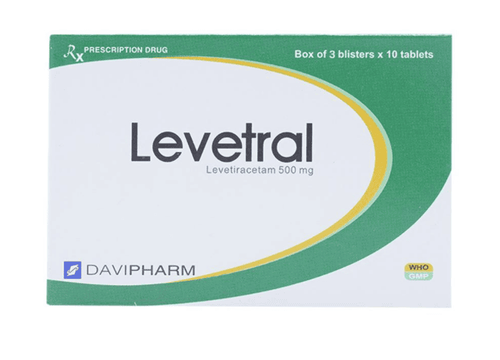This is an automatically translated article.
Leptica drug is used in the treatment of diseases such as neuralgia, fibromyalgia, epilepsy,... Leptica has the main ingredient Pregabalin. The following article would like to provide the most detailed information about the drug Leptica.
1. What is Leptica?
Leptica belongs to the group of psychotropic drugs, made in the form of hard capsules and packed in boxes of 3 blisters x 10 tablets.
Leptica medicine has the main ingredient Pregabalin 75mg and other excipients.
2. Indications for taking Leptica
Leptica is used in the following cases:
Treatment of neuropathic pain associated with peripheral neuropathy in patients with diabetes. Treatment of postherpetic neuralgia. Adjuvant therapy for adult patients with partial-onset seizures. Treatment of fibromyalgia. Treatment of neuropathic pain associated with spinal cord injury.
3. Dosage - How to take Leptica
3.1. How to take Leptica is to be taken orally with water. Patients can drink before or after meals because they do not depend on meals. During treatment with Leptica, patients should not stop taking the drug suddenly.
3.2. Dosage The dose of Leptica drug will depend on the subject and the progression of the disease, the Leptica dose refer to the following:
Neuropathic pain associated with peripheral neuropathy in patients with diabetes:
The maximum recommended dose is 100 mg of pregabalin three times daily (300 mg of pregabalin per day) in patients with a creatinine clearance of at least 60 mL/min. Start taking 50mg Pregabalin x 3 times/day (150mg Pregabalin/day). The dose may be increased to 300mg of Pregabalin/day for 1 week based on efficacy and tolerability. Since Pregabalin is eliminated primarily by the kidneys, dose adjustment is required in patients with reduced renal function. Do not exceed 300mg of Pregabalin/day. Treatment of postherpetic neuralgia:
The recommended dose is 75-150 mg Pregabalin x 2 times/day, or 50-100mg Pregabalin x 3 times/day (150-300mg Pregabalin/day) in patients with creatinine clearance. at least 60mL/min. Start taking the drug at a dose of 75mg Pregabalin x 2 times/day, or 50mg Pregabalin x 3 times/day (150mg Pregabalin/day). The dose may be increased to 300 mg of Pregabalin/day for 1 week based on efficacy and tolerability. Since Pregabalin is eliminated primarily by the kidneys, dose adjustment is required in patients with impaired renal function. If after 2 to 4 weeks of treatment the patient does not have pain relief with 300 mg of pregabalin/day and can tolerate higher doses, the dose can be increased to 300 mg of pregabalin twice a day, or 200 mg of pregabalin three times a day (600mg Pregabalin/day). Adjunctive treatment for adults with partial onset seizures:
Dosage 150-600mg Pregabalin/day. The total daily dose of Pregabalin should be divided into 2-3 doses. The total daily dose of Pregabalin should start at no more than 150 mg/day (75 mg Pregabalin twice daily, or 50 mg Pregabalin three times daily). Based on individual patient response and tolerability, the dose may be increased to a maximum dose of 600 mg Pregabalin/day. Pregabalin dose adjustment is required in patients with reduced renal function. Treatment of fibromyalgia:
The recommended dose is 300-450mg of Pregabalin/day. Start taking the drug at a dose of 75mg Pregabalin x 2 times/day (150mg Pregabalin/day). The dose may be increased to 150 mg Pregabalin twice daily (300 mg Pregabalin per day) within 1 week. Patients who do not achieve a therapeutic effect with 300 mg of pregabalin/day can be increased to 225 mg of pregabalin twice a day (450 mg of pregabalin/day). The recommended dose should not exceed 450mg of Pregabalin/day. Pregabalin dose adjustment is required in patients with reduced renal function. Neuropathic pain associated with spinal cord injury:
The recommended dose is 150-600mg Pregabalin/day. The recommended starting dose is 75mg Pregabalin twice daily (150mg Pregabalin/day). The dose may be increased to 150 mg Pregabalin twice daily (300 mg Pregabalin per day) within 1 week. Patients who do not achieve the therapeutic effect after 2-3 weeks with 150mg Pregabalin x 2 times/day can increase the dose to 300mg Pregabalin x 2 times/day. Pregabalin dose adjustment is required in patients with reduced renal function. 3.3. What to do in case of missed dose or overdose of Leptica? In case of overdose of Leptica and signs of coma or inability to breathe, call 911 immediately.
If the patient forgets a dose of Leptica, take it as soon as possible. However, if it is almost time for your next Leptica dose, skip the missed dose and take your next Leptica dose at the scheduled time. Do not double the prescribed dose of Leptica.
4. Contraindications to the use of Leptica
Leptica drug should not be used in cases where the patient has a history of allergy or hypersensitivity to any ingredient of the drug.
5. Leptica . drug interactions
Some drugs when combined with Leptica may increase the side effects of Pregabalin causing dizziness or drowsiness such as: Cold medicine, allergy medicine, narcotic pain medicine, sedatives, sleeping pills, muscle relaxants, depression/anxiety drugs,...
There are also some other drugs that cause interactions when combined such as:
Rosiglitazone such as Avandia, Avandaryl, Avandamet. Heart and blood pressure medications such as: Vasotec, benazepril/Lotensin, enalapril lisinopril (Prinivil, Zestril), quinapril/Accupril, ramipril/Altace.
6. Side effects when taking Leptica
During the use of Leptica, patients may experience some unwanted side effects such as:
Common:
Fatigue, dizziness, headache Dry mouth, nausea, vomiting, constipation, fullness gas, increased appetite, weight gain Difficulty concentrating, decreased attention, confusion, forgetfulness, mood swings, language problems, anxiety, lack of coordination. Unsteady walking, loss of balance, uncontrollable movement of a body part, muscle twitching, weakness, swelling of the hands, hands, feet, ankles or legs, back pain. Serious side effects:
Double vision, blurred vision, impaired vision or other changes in vision. Hives, itchy skin, blistering, rash. Swelling of the face, mouth, eyes, throat, lips, gums, tongue, head and neck Difficulty breathing, wheezing, chest tightness, muscle pain with fever. If you have any sores, redness, or skin problems, contact your doctor immediately. In addition, Leptica may cause other side effects that have not been listed or verified. Call your doctor if you have any unusual problems while taking Leptica.
7. Precautions when using Leptica
Cautiously use Leptica for patients with kidney failure, diabetes, cardiovascular disease, factors that can promote encephalopathy, and the elderly.
If it is necessary to discontinue Leptica, it should be discontinued gradually over a minimum of 1 week.
The safety and efficacy of Leptica have not been established in children < 12 years of age and adolescents (12-17 years of age).
Stop taking Leptica as soon as symptoms of angioedema appear.
When the patient is pregnant should not use, only use Leptica when absolutely necessary and prescribed by the treating doctor.
Stop breastfeeding during treatment with Leptica .
Hopefully with the sharing of Leptica drug, it will help users to use the drug effectively, safely and minimize the unnecessary side effects. If you have any further questions, you can contact your doctor for specific advice.













